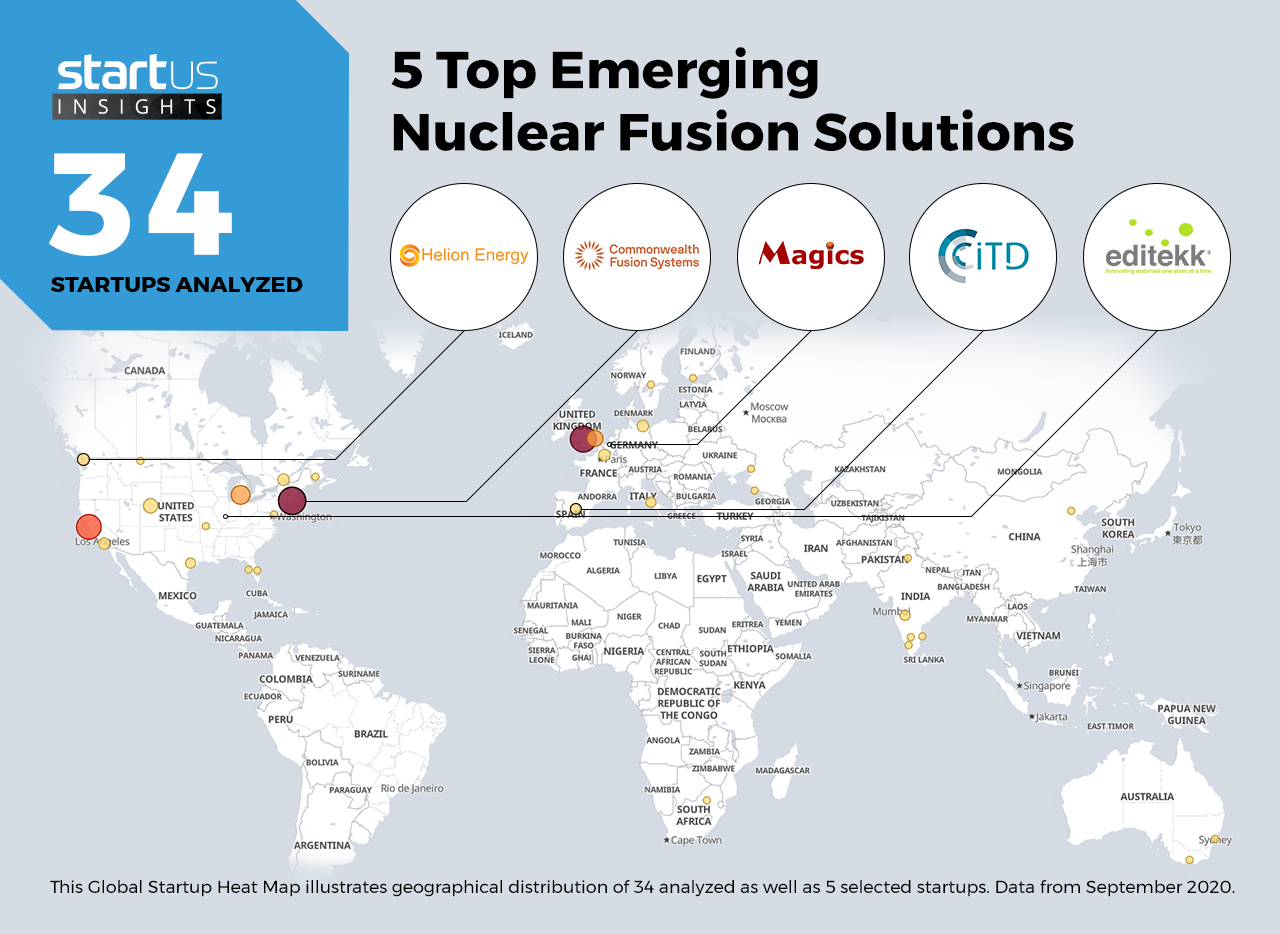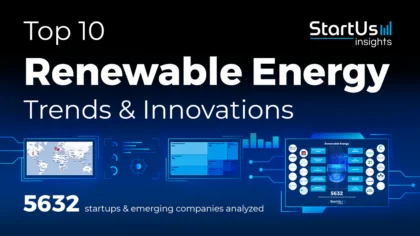Our Innovation Analysts recently looked into emerging technologies and up-and-coming startups working on innovative solutions for the energy sector. As there is a large number of startups working on a wide variety of solutions, we decided to share our insights with you. This time, we are taking a look at 5 promising nuclear fusion solutions.
Heat Map: 5 Top Nuclear Fusion Solutions
Using our StartUs Insights Discovery Platform, covering 1.379.000+ startups & scaleups globally, we looked at innovation in the field of energy. For this research, we identified 34 relevant solutions and picked 5 to showcase below. These companies were chosen based on a data-driven startup scouting approach, taking into account factors such as location, founding year, and relevance of technology, among others. Depending on your specific criteria, the top picks might look entirely different.
The Global Startup Heat Map below highlights 5 startups & scaleups developing innovative solutions for nuclear fusion. Moreover, the Heat Map reveals regions that observe a high startup activity and illustrates the geographic distribution of all 34 companies we analyzed for this specific topic.
Commonwealth Fusion Systems – Fusion Energy Systems
The increasingly apparent effects of climate change and a finite supply of fossil fuels push energy companies to develop novel ways to generate nuclear energy without harming the environment. The benefits of fusion power include increased energy efficiency and an abundance of fuel, making it an attractive option to pursue. Advancements in the materials industry further support startups creating innovative heat exchangers, magnetic superconductors, and tokamaks for nuclear fusion reactors.
The US-based startup Commonwealth Fusion Systems builds SPARC, a nuclear fusion device that produces plasmas that generate more energy than they consume. SPARC enables the generation of carbon-free, safe, and limitless fusion power with the help of the Alcator C-Mod, a compact high-field tokamak, as well as high-temperature superconductor (HTS) magnets. The startup is constructing its own commercial nuclear fusion plant, ARC, and plans to start commercial energy production by 2025.
CITD Engineering & Technologies – Fusion System Components
The process of nuclear fusion requires temperatures exceeding 100 million Kelvin for hydrogen ions to collide and fuse as plasma. Such high temperatures require a superconducting magnetic field. Startups develop components for fusion reactors such as tokamaks, advanced electrical systems, and fluid systems to help contain and regulate plasma generation.
Spanish startup CITD Engineering & Technologies provides electromechanical, robotic, and mechanical components for nuclear fusion systems and particle accelerators. CITD designs complex mechanical parts, electrical systems, and fluid systems to withstand extreme temperatures in addition to static and seismic stress. CITD provides engineering services to organizations such as International Thermonuclear Experimental Reactor (ITER) and European Laboratory for Particle Physics (CERN), as well as clients in the aeronautics, defense, and space industries.
Magics Instruments – Systems-On-A-Chip (SoC)
Plasma loses its heat and interacts with surrounding materials almost instantaneously. Successful plasma containment plays a significant role in nuclear fusion reactions. This, in turn, encourages startups to use technologies such as artificial intelligence (AI) and machine learning (ML) to predict errors in plasma containment. This also supports tokamaks in sustaining fusion reactions. Integrated ML-based SoC solutions to monitor and predict anomalies in the plasma helps in advancing the fusion process.
Belgian startup Magics Instruments provides integrated systems-on-a-chip solutions for applications in nuclear fusion. The startup enables motion control, condition monitoring, and intelligent sensing in plasma fusion reactors. The solutions use radiation-hardened, low-power, and intelligent sensors to achieve this. The startup’s sensors utilize ML and deep learning for continuous real-time machine health monitoring. The startup also extracts raw sensor data to detect and analyze anomalies in the functioning of components.
Editekk – Surface Coatings
Although fusion reactions do not generate any radioactive waste, the reactor components become radioactive over time. The level of radioactivity significantly depends on the materials used in various components. Advancements in nanotechnology enable organizations to use innovative materials that exhibit custom properties to specific stimuli. Startups develop various material innovations, for example, to withstand extreme temperatures without deterioration.
The US-based startup Editekk creates custom multi-functional surfaces, interfaces, and coatings for fusion energy applications. The startup creates micro and nanoscale surface features that enable a range of desired properties. These include wettability, biocompatibility and functionality, composition, surface energy, and electronic properties. Editekk’s technology utilizes a hybrid material system for equipment surfaces. It greatly extends the life of nuclear fusion eactor equipment and also reduces the chances of radiation damage over time.
Helion Energy – Inertial Confinement Fusion (ICF)
Traditionally, nuclear fusion utilizes magnetic confinement to manage plasma generation. On the other hand, ICF uses deuterium, the size of a pinhead, as a fuel source. Deuterium is extracted from water, making it an increasingly viable fuel option for fusion reactions. Advancements in nuclear research encourage startups to explore different confinement techniques for clean energy generation.
The US-based scaleup Helion Energy is developing a fusion engine that is a near term and low-cost solution for sustainable clean energy. The startup combines the stability of magnetic fusion and the heating of pulsed inertial fusion to generate energy. Helion Energy uses deuterium as fuel and uses magnetic fields operated with advanced solid-state electronics to compress and heat it. This process of fusion reaction generates Helium-3 as a by-product, which finds applications in quantum computing as well as in medical imaging.
What About The Other 29 Solutions?
While we believe data is key to creating insights it can be easy to be overwhelmed by it. Our ambition is to create a comprehensive overview and provide actionable innovation intelligence and enable you to achieve your goals faster. The 5 nuclear fusion solutions showcased above are promising examples out of 34 we analyzed for this article. To identify the most relevant solutions based on your specific criteria, get in touch.


![Dive into the Top 10 Energy Industry Trends and Innovations [2025]](https://www.startus-insights.com/wp-content/uploads/2025/03/Energy-Trend-SharedImg-StartUs-Insights-noresize-420x236.webp)






